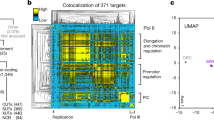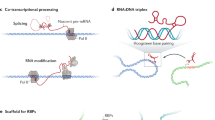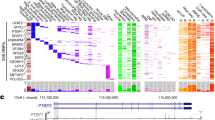Abstract
We determined the distribution of repressor-activator protein 1 (Rap1) and the accessory silencing proteins Sir2, Sir3 and Sir4 in vivo on the entire yeast genome, at a resolution of 2 kb. Rap1 is central to the cellular economy during rapid growth, targeting 294 loci, about 5% of yeast genes, and participating in the activation of 37% of all RNA polymerase II initiation events in exponentially growing cells. Although the DNA sequence recognized by Rap1 is found in both coding and intergenic sequences, the binding of Rap1 to the genome was highly specific to intergenic regions with the potential to act as promoters. This global phenomenon, which may be a general characteristic of sequence-specific transcriptional factors, indicates the existence of a genome-wide molecular mechanism for marking promoter regions.
This is a preview of subscription content, access via your institution
Access options
Subscribe to this journal
Receive 12 print issues and online access
$209.00 per year
only $17.42 per issue
Buy this article
- Purchase on Springer Link
- Instant access to full article PDF
Prices may be subject to local taxes which are calculated during checkout




Similar content being viewed by others
References
Moretti, P., Freeman, K., Coodly, L. & Shore, D. Evidence that a complex of Sir proteins interacts with the silencer and telomere-binding protein Rap1. Genes Dev. 8, 2257–2269 (1994).
Shore, D. Telomerase and telomere-binding proteins: controlling the endgame. Trends Biochem. Sci. 22, 233–235 (1997).
Aparicio, O.M., Billington, B.L. & Gottschling, D.E. Modifiers of position effect are shared between telomeric and silent mating-type loci in S. cerevisiae. Cell 66, 1279–1287 (1991).
Konig, P., Giraldo, R., Chapman, L. & Rhodes, D. The crystal structure of the DNA-binding domain of yeast Rap1 in complex with telomeric DNA. Cell 85, 125–136 (1996).
Cockell, M. et al. The carboxy termini of Sir4 and Rap1 affect Sir3 localization: evidence for a multicomponent complex required for yeast telomeric silencing. J. Cell Biol. 129, 909–924 (1995).
Hecht, A., Laroche, T., Strahl-Bolsinger, S., Gasser, S.M. & Grunstein, M. Histone H3 and H4 N-termini interact with Sir3 and Sir4 proteins: a molecular model for the formation of heterochromatin in yeast. Cell 80, 583–592 (1995).
Guarente, L. Sir2 links chromatin silencing, metabolism, and aging. Genes Dev. 14, 1021–1026 (2000).
Warner, J.R. The economics of ribosome biosynthesis in yeast. Trends Biochem. Sci. 24, 437–440 (1999).
Morse, R.H. Rap, Rap, open up! New wrinkles for Rap1 in yeast. Trends Genet. 16, 51–53 (2000).
Li, B., Oestreich, S. & de Lange, T. Identification of human Rap1: implications for telomere evolution. Cell 101, 471–483 (2000).
Graham, I.R., Haw, R.A., Spink, K.G., Halden, K.A. & Chambers, A. In vivo analysis of functional regions within yeast Rap1p. Mol. Cell. Biol. 19, 7481–7490 (1999).
Freeman, K., Gwadz, M. & Shore, D. Molecular and genetic analysis of the toxic effect of Rap1 overexpression in yeast. Genetics 141, 1253–1262 (1995).
Wyrick, J.J. et al. Chromosomal landscape of nucleosome-dependent gene expression and silencing in yeast. Nature 402, 418–421 (1999).
Reid, J.L., Iyer, V.R., Brown, P.O. & Struhl, K. Coordinate regulation of yeast ribosomal protein genes is associated with targeted recruitment of Esa1 histone acetylase. Mol. Cell 6, 1297–1307 (2000).
Iyer, V.A. et al. Genomic binding distribution of the yeast cell-cycle transcription factors SBF and MBF. Nature 409, 533–538 (2001).
Conrad, M.N., Wright, J.H., Wolf, A.J. & Zakian, V.A. Rap1 protein interacts with yeast telomeres in vivo: overproduction alters telomere structure and decreases chromosome stability. Cell 63, 739–750 (1990).
Gotta, M. et al. The clustering of telomeres and colocalization with Rap1, Sir3, and Sir4 proteins in wild-type Saccharomyces cerevisiae. J. Cell Biol. 134, 1349–1363 (1996).
Strahl-Bolsinger, S., Hecht, A., Luo, K. & Grunstein, M. Sir2 and Sir4 interactions differ in core and extended telomeric heterochromatin in yeast. Genes Dev. 11, 83–93 (1997).
Hecht, A., Strahl-Bolsinger, S. & Grunstein, M. Spreading of transcriptional repressor Sir3 from telomeric heterochromatin. Nature 383, 92–96 (1996).
Pryde, F.E. & Louis, E.J. Limitations of silencing at native yeast telomeres. EMBO J. 18, 2538–2550 (1999).
Donze, D., Adams, C.R., Rine, J. & Kamakaka, R.T. The boundaries of the silenced HMR domain in Saccharomyces cerevisiae. Genes Dev. 13, 698–708 (1999).
Lascaris, R.F., Mager, W.H. & Planta, R.J. DNA-binding requirements of the yeast protein Rap1p as selected in silico from ribosomal protein gene promoter sequences. Bioinformatics 15, 267–277 (1999).
Costanzo, M.C. et al. The yeast proteome database (YPD) and Caenorhabditis elegans proteome database (WormPD): comprehensive resources for the organization and comparison of model organism protein information. Nucleic Acids Res. 28, 73–76 (2000).
Remacle, J.E. & Holmberg, S. A REB1-binding site is required for GCN4-independent ILV1 basal level transcription and can be functionally replaced by an ABF1-binding site. Mol. Cell. Biol. 12, 5516–5526 (1992).
Gonçalves, P.M. et al. C-terminal domains of general regulatory factors Abf1p and Rap1p in Saccharomyces cerevisiae display functional similarity. Mol. Microbiol. 19, 535–543 (1996).
Cherry, J.M. et al. Saccharomyces Genome Database. 12/01/1999 edn Vol. 1999 (2000).
Mewes, H.W. et al. MIPS: a database for genomes and protein sequences. Nucleic Acids Res. 27, 44–48 (1999).
Lopez, N., Halladay, J., Walter, W. & Craig, E.A. SSB, encoding a ribosome-associated chaperone, is coordinately regulated with ribosomal protein genes. J. Bacteriol. 181, 3136–3143 (1999).
Holstege, F.C. et al. Dissecting the regulatory circuitry of a eukaryotic genome. Cell 95, 717–728 (1998).
Liu, X., Brutlag, D.L. & Liu, J.S. BioProspector: discovering conserved DNA motifs in upstream regulatory regions of co-expressed genes. Pac. Symp. Biocomput. 127–138 (2001).
Graham, I.R. & Chambers, A. Use of a selection technique to identify the diversity of binding sites for the yeast Rap1 transcription factor. Nucleic Acids Res 22, 124–130 (1994).
Buchman, A.R., Kimmerly, W.J., Rine, J. & Kornberg, R.D. Two DNA-binding factors recognize specific sequences at silencers, upstream activating sequences, autonomously replicating sequences, and telomeres in Saccharomyces cerevisiae. Mol. Cell. Biol. 8, 210–225 (1988).
Idrissi, F.Z. & Piña, B. Functional divergence between the half-sites of the DNA-binding sequence for the yeast transcriptional regulator Rap1p. Biochem. J. 341, 477–482 (1999).
Tjian, R. & Maniatis, T. Transcriptional activation: a complex puzzle with few easy pieces. Cell 77, 5–8 (1994).
Leblanc, B.P., Benham, C.J. & Clark, D.J. An initiation element in the yeast CUP1 promoter is recognized by RNA polymerase II in the absence of TATA box-binding protein if the DNA is negatively supercoiled. Proc. Natl. Acad. Sci. USA 97, 10745–10750 (2000).
Peterson, C.L. & Workman, J.L. Promoter targeting and chromatin remodeling by the SWI/SNF complex. Curr. Opin. Genet. Dev. 10, 187–192 (2000).
Acknowledgements
We thank V. Iyer for initiating work on the intergenic yeast array, and other members of the Brown and Botstein labs for advice and technical support. We thank D. Brutlag and J. Liu for advice in developing BioProspector, J. Derisi for software that maps the IP data, and J. Rine for yeast strains. This work was supported by a grant from the National Human Genome Research Institute and by the Howard Hughes Medical Institute. P.O.B. is an associate investigator of the Howard Hughes Medical Institute, and the Helen Hay Whitney Foundation supports J.D.L.
Author information
Authors and Affiliations
Corresponding author
Supplementary information
Web Figure H:
Download the .cdt, .gtr, and .pcl files corresponding to the cluster of gene expression profiles for the genes downstream of intergenic fragments selected by the Rap1p IP. These files must be loaded into Treeview to view the clusters. Instructions for using Treeview (http://rana.lbl.gov/EisenSoftware.htm) can be found in the Treview Manual.
Rights and permissions
About this article
Cite this article
Lieb, J., Liu, X., Botstein, D. et al. Promoter-specific binding of Rap1 revealed by genome-wide maps of protein–DNA association. Nat Genet 28, 327–334 (2001). https://doi.org/10.1038/ng569
Received:
Accepted:
Published:
Issue Date:
DOI: https://doi.org/10.1038/ng569
This article is cited by
-
Physiological function of FKBP12, a primary target of rapamycin/FK506: a newly identified role in transcription of ribosomal protein genes in yeast
Current Genetics (2021)
-
Dynamics of gene expression regulatory proteins in the living cell nucleus
Journal of the Korean Physical Society (2021)
-
Assessment of the ptxD gene as a growth and selective marker in Trichoderma atroviride using Pccg6, a novel constitutive promoter
Microbial Cell Factories (2020)
-
Functional duplication of Rap1 in methylotrophic yeasts
Scientific Reports (2019)
-
DNA–protein interaction: identification, prediction and data analysis
Molecular Biology Reports (2019)



